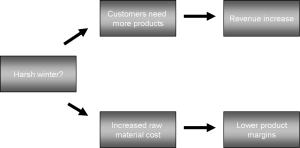What if analysis
What do Steve Jobs, Albert Einstein, Thomas Watson and Pep Guardiola (coach of FC Barcelona) have in common? – All of them have challenged the old and set ways of doing things. Challenging old ways provided them with new opportunities and their success speaks for itself. That raises a question: What can we do to challenge set views to be more successful? Indeed, there is a very simple tool that most of us ignore: what if analysis.
What If?
Asking what if can help us see our world in a new and fresh way. Why? Humans are creatures of habit. We are often stuck in our old and set ways and often see just the familiar patterns around us. This limits our thinking and we often miss opportunities or risks. It restricts our creativity. Take a look at Kodak. If we can trust reports in the newspapers, former management assumed that film and paper photography would prevail. That’s what most employees were comfortable with. What if digital photography became the standard?
What if analysis can therefore help us identify risks and opportunities. What if analysis can help us make better decisions about the future.
“Creativity is the ability to see things in a new way, a way that combines existing things, viewpoints, elements, in a way that hasn’t been done, or in a way that uniquely solves a problem. It is, in short, the power of “What if…?” David du Chemin, Photographer
Examples of what if analysis
What if analysis can be extremely powerful in business. Think about these questions:
- What if air traffic was shut down due to another volcano? What would this do to our supply chain?
- What if we offered our client a new discount model? Would they buy more products in the future?
- What if we were able to reduce our expenses by 5%? How much flexibility would we gain?
- What if every employee reduced their business travel by just one trip per year?
- What if we changed our fixed phone plans to variable ones? Would we be able to save cost?
Developing those what if questions is the first step. The second step requires us to understand the answers and the potential impact on our business.
Obstacles to what if analysis

It is the second step where we need to sit down and play with our planning and forecasting models. We sometimes even have to create small models from scratch to identify the right answers and solutions. But that part is often too complicated. Corporate data is complex. Spreadsheets are often too cumbersome and slow to handle the complexity. As a result, too many people shy away from performing what if analysis.
Start: What if analysis
Start asking what if questions today. It is a very powerful too, indeed. And it is not only limited to business.


Comments
2 responses to “The power of what if analysis”